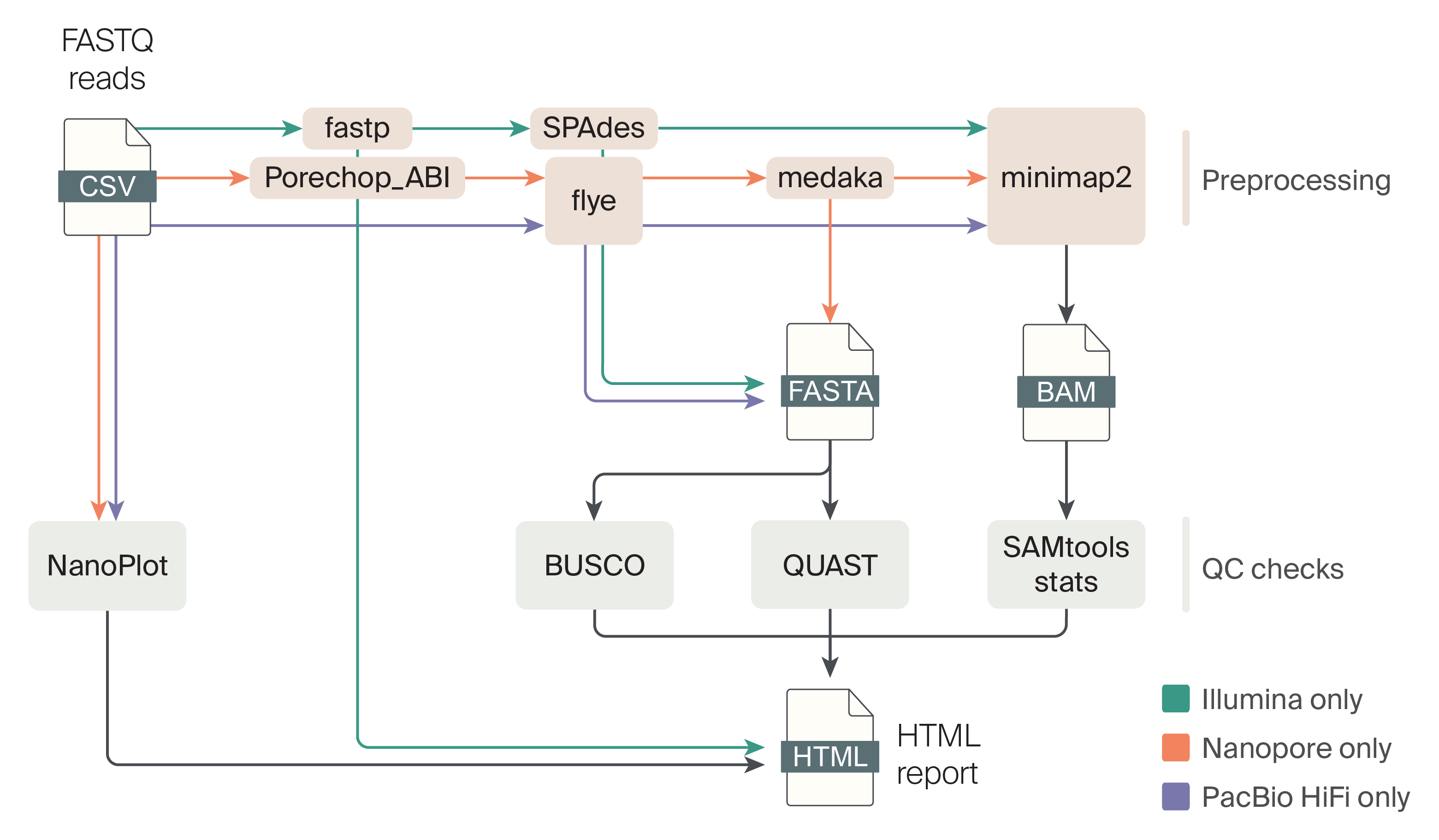Arcadia-Science/reads2genome is a pipeline that performs QC checks and assembly on reads from different sequencing technologies obtained from a single organism. The pipeline produces a draft assembly and several statistics for assessing quality.
The pipeline is built using Nextflow, a workflow tool to run tasks across multiple compute infrastructures in a very portable manner. It uses Docker/Singularity containers making installation trivial and results highly reproducible. The Nextflow DSL2 implementation of this pipeline uses one container per process which makes it much easier to maintain and update software dependencies. Where possible, these processes have been submitted to and installed from nf-core/modules in order to make them available to all nf-core pipelines, and to everyone within the Nextflow community!
The workflow supports reads in .fastq format from either Illumina, Nanopore, or Pacbio technologies. Assemblies are produced from the reads and assembly statistics summarized with QUAST, reads mapped back to the assembly and mapping statistics produced with samtools stat and lineage-specific QC statistics produced with BUSCO. The workflow then reports these QC stats into an HTML report produced with MultiQC.
-
Install Nextflow (>=22.10.1)
-
Install Docker, Singularity (you can follow this tutorial), or Conda. You can use conda to install Nextflow itself but use it for managing software within pipelines as a last resort. We recommend using Docker if possible as this has been tested most frequently. See the nf-core docs) for more information.
-
Download the pipeline and test it on the minimal datasets for either Illumina, Nanopore, or Pacbio:
nextflow run Arcadia-Science/reads2genome -profile test_illumina,YOURPROFILE --outdir <OUTDIR>
nextflow run Arcadia-Science/reads2genome -profile test_nanopore,YOURPROFILE --outdir <OUTDIR>
nextflow run Arcadia-Science/reads2genome -profile test_pacbio,YOURPROFILE --outdir <OUTDIR>
Note that some form of configuration will be needed so that Nextflow knows how to fetch the required software. This is usually done in the form of a config profile (YOURPROFILE in the example command above). You can chain multiple config profiles in a comma-separated string.
- The pipeline comes with several config profiles, but we recommend using
dockerwhen possible, such as-profile test,docker.- Please check nf-core/configs to see if a custom config file to run nf-core pipelines already exists for your institute. If so, you can simply use
-profile <institute>in your command. This will enable eitherdockerorsingularityand set the appropriate execution settings for your local compute environment.- If you are using
singularity, please use thenf-core downloadcommand to download images first, before running the pipeline. Setting theNXF_SINGULARITY_CACHEDIRorsingularity.cacheDirNextflow options enables you to store and re-use the images from a central location for future pipeline runs.- If you are using
conda, it is highly recommended to use theNXF_CONDA_CACHEDIRorconda.cacheDirsettings to store the environments in a central location for future pipeline runs.
- Start running your own analysis! Prior to running the workflow, you will need to select a BUSCO lineage to compare against the assemblies produced in the pipeline. You can find a list of accepted BUSCO lineages here.
nextflow run Arcadia-Science/reads2genome --input samplesheet.csv --outdir <OUTDIR> --platform <illumina|nanopore|pacbio> --lineage <BUSCO_LINEAGE> -profile <docker/singularity/conda/institute>
For more documentation on usage, output, and specifying queue directives in Tower for differentiating processes to run via spot or on-demand AWS Batch instances, see the docs.
This cookiecutter template is based off of the nf-core template. You can cite the nf-core publication as follows:
The nf-core framework for community-curated bioinformatics pipelines.
Philip Ewels, Alexander Peltzer, Sven Fillinger, Harshil Patel, Johannes Alneberg, Andreas Wilm, Maxime Ulysse Garcia, Paolo Di Tommaso & Sven Nahnsen.
Nat Biotechnol. 2020 Feb 13. doi: 10.1038/s41587-020-0439-x.
An extensive list of references for the tools used by the pipeline can be found in the CITATIONS.md file.




